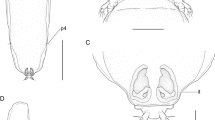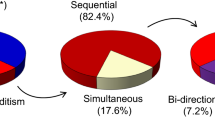Abstract
During 2005 monthly samples of the solitary ascidian Herdmania momus were collected along the Mediterranean and Red Sea coasts of Israel, in order to investigate possible differences in life history strategies of the two populations. The samples were preserved, dissected, and measurements were made of length, total weight, gonad weight, oocyte diameter and the occurrence of symbionts was recorded. Additionally, field surveys showed that in the Mediterranean H. momus exclusively inhabit artificial substrates, and are common at greater depths than in Eilat (Red Sea). Individuals of H. momus in Eilat reproduced year round. Although individuals from the Mediterranean were significantly larger than individuals collected in Eilat their gonad indices and oocyte diameter measurements indicate that they have a short reproductive season. Copepods were found in 50% of the samples from both sites, while a pontoniine shrimp was found in 14% of the samples from Eilat only. The marked differences between the native vs. non-indigenous populations of H. momus are attributed to differential food availability, water temperature, currents and wave exposure. The increasing evidence of negative effects of non-indigenous ascidians on natural fauna from other regions in the world emphasizes the need for additional research regarding the ecology of ascidians along the coasts of Israel.




Similar content being viewed by others
References
Atad I (2005) The limpet Cellana rota as a Lessepsian migrant model: arrival, establishment and competition with the Mediterranean limpet, Patella caerulea. MSc thesis, Tel Aviv University, 66 pp
Barash A, Danin Z (1992) Fauna Palestina, Mollusca I, annotated list of Mediterranean molluscs of Israel and Sinai. Keter Press Enterprises, Jerusalem
Becerro MA, Turon X (1992) Reproductive cycles of the ascidians Microcosmus sabatieri and Halocynthia papillosa in the Northwestern Mediterranean. PSZN I: Mar Ecol 13:363–373
Berrill NJ (1950) The Tunicata with an account of the British species. Ray Society, London
Cohen AN, Harris LH, Bingham BL, Carlton JT, Chapman JW, Lambert CC, Lambert G, Ljubenkov JC, Murray SN, Rao LC, Reardon K, Schwindt E (2005) Rapid assessment survey for exotic organisms in southern California bays and harbors, and abundance in port and non-port areas. Biol Invasions 7:995–1002
Coles SL, DeFelice RC, Eldredge LG, Carlton JT (1999) Historical and recent introductions of non-indigenous marine species into Pearl Harbor, Oahu, Hawaiian Islands. Mar Biol 135:147–158
Dalby JE (1996) Nemertean, copepod, and amphipod symbionts of the dimorphic ascidian Pyura stolonifera near Melbourne, Australia: specificities to host morphs and factors affecting prevalences. Mar Biol 126:231–243
Davis AR (1989) Contrasting population dynamics and life histories in two populations of the colonial subtidal ascidian Podoclavella moluccensis. Mar Ecol Prog Ser 51:107–119
Degnan BM, Rhode PR, Lavin MF (1996) Normal development and embryonic activity of the ascidian Herdmania momus. Mar Freshw Res 47:543–551
Diamant A (1998) Parasitological aspects of Red-Med fish migration. Actes du Colloque Scientifique. In: Proc Intl Sci Colloq OCEANOS Montpellier, France, 11–12 April 1996, pp 175–178
Durante KM, Sebens KP (1994) Reproductive ecology of the ascidians Molgula citrina (Alder & Hancock, 1848) and Aplidium glabrum (Verrill, 1871) from the Gulf of Maine, USA. Ophelia 39:1–21
Fishelson L (2000) Marine animal assemblages along the littoral of the Israeli Mediterranean seashore: the Red-Mediterranean Seas communities of species. Ital J Zool 67:393–415
Fransen CHJM (2002) Taxonomy, phylogeny, historical biogeography, and historical ecology of the genus Pontonia Latreille (Crustacea: Decapoda: Caridea: Palaemonidae). Zool Verh Leiden 336:1–433
Galil BS (2000) A sea under siege – alien species in the Mediterranean. Biol Invasions 2:77–186
Ghobashy AFA, Adbel Messeih MK (1991) Ascidians in Egyptian waters. J Egypt Ger Soc Zool 4:313–326
Golani D (1990) Environmentally-induced meristic changes in Lessepsian fish migrants, a comparison of source and colonizing populations. Bull Inst Océanogr Monaco 7:143–152
Golani D (1998) Impact of Red Sea fish migrants through the Suez Canal on the aquatic environment of the Eastern Mediterranean. Bull Yale Univ Sch Forest Environ Stud 103:375–385
Goodbody I (1961) Continuous breeding in three species of tropical ascidians. Proc Zool Soc Lond 136:403–409
Goodbody I (1962) The biology of Ascidia nigra (Savigny). I. Survival and mortality in an adult population. Biol Bull 12:40–51
Goren M, Galil BS (2005) A review of changes in the fish assemblages of Levantine inland and marine ecosystems following the introduction of non-native fishes. J Appl Ichthyol 21:364–370
Grosholz E (2002) Ecological and evolutionary consequences of coastal invasions. Trends Ecol Evol 17:22–27
Harant H (1927) Rapport sur les Tuniciers, Cambridge expedition to the Suez Canal, 1924. Trans Zool Soc Part 3:365–373
Kohler KE, Gill SM (2006) Coral Point Count with Excel extensions (CPCe): a visual basic program for the determination of coral and substrate coverage using random point count methodology. Comput Geosci 32:1259–1269
Kott P (1985) The Australian Ascidiacea. Part 1:Phelobranchiata and Stolidobranchiata. Mem Queensl Mus 23:1–440
Kott P (2002) The genus Herdmania Lahille, 1888 (Tunicata, Ascidiacea) in Australian waters. Zool J Linn Soc Lond 134:359–374
Lambert G (2002) Nonindigenous ascidians in tropical waters. Pac Sci 56:291–298
Lambert G (2003) Marine biodiversity of Guam: the Ascidiacea. Micronesica 35–36:588–597
Lambert CC, Lambert G (1998) Non-indigenous ascidians in southern California harbours and marinas. Mar Biol 130:675–688
Lambert CC, Lambert G (2003) Persistence and differential distribution of nonindigenous ascidians in harbors of the Southern California Bight. Mar Ecol Prog Ser 259:145–161
Lotan A, Fine M, Ben-Hillel R (1994) Synchronization of the life cycle and dispersal pattern of the tropical invader scyphomedusan Rhopilema nomadica is temperature dependent. Mar Ecol Prog Ser 109:59–65
Loya Y (2004) The coral reefs of Eilat – past, present and future: three decades of coral community structure studies. In: Rosenberg E, Loya Y (eds) Coral health and disease. Springer-Verlag, Heidelberg, pp 1–34
Mastrototaro F, Dappiano M (2005) New record of the non indigenous species Microcosmus squamiger Michaelsen, 1927 (Ascidiacea, Stolidobranchia) in the harbour of Salerno (Tyrrhenian Sea, Italy). JMBA-Biodiversity records. http://www.mba.ac.uk/jmba/pdf/5124.pdf Cited 15 July 2007
Millar RH (1952) The annual growth and reproductive cycle in four ascidians. J Mar Biol Assoc UK 31:41–61
Millar RH (1954) The annual growth and reproductive cycle of the ascidian Dendrodoa grossularia (van Beneden). J Mar Biol Assoc UK 33:33–48
Millar RH (1971) The biology of ascidians. Adv Mar Biol 9:1–100
Millar RH (1974) A note on the breeding season of three ascidians on coral reefs at Galeta in the Caribbean Sea. Mar Biol 23:127–129
Monniot C, Monniot F, Laboute P (1991) Coral reef ascidians of New Caledonia. ORSTOM, Paris
Naranjo SA, Caraballo JL, Garcìa-Gómez JC (1996) Effects of environmental stress on ascidian populations in Algeciras Bay (southern Spain). Possible marine bioindicators? Mar Ecol Prog Ser 144:119–131
Nishikawa T (2002) Revision of the genus Herdmania (Urochordata: Ascidiacea) inhabiting Japanese waters. Species Divers 7:217–250
Nomaguchi TA, Nishijima C, Minowa S, Hashimoto M, Haraguchi C, Amemiya S, Fujisawa H (1997) Embryonic thermosensitivity of the ascidian Ciona savignyi. Zool Sci (Tokyo) 14:511–516
Oren U, Benayahu Y (1998) Didemnid ascidians: rapid colonizers of artificial reefs in Eilat (Red Sea). Bull Mar Sci 63:199–206
Pérès JM (1958) Ascidies recoltees sur les cotes mediterraneannes d’Israel. Bull Res Counc Israel 7B:143–150
Por FD (1978) Lessepsian migration. The Influx of Red Sea Biota into the Mediterranean by Way of the Suez Canal. Springer-Verlag, Berlin, 228 pp
Rahmstorf S, Ganopolski A (1999) Long-term global warming scenarios computed with an efficient coupled climate model. Clim Change 43:353–367
Rilov G, Benayahu Y, Gasith A (2004) Prolonged lag in population outbreak of an invasive mussel: a shifting-habitat model. Biol Invasions 6:347–364
Rocha RM, Lotufo TMC, Rodrigues SA (1999) The biology of Phallusia nigra Savigny, 1816 (Tunicata: Ascidiacea) in southern Brazil: spatial distribution and reproductive cycle. Bull Mar Sci 64:77–87
Safriel UN, Ritte U (1986) Population biology of Suez Canal migration – which way, what kind of species and why. In: Karlin S, Nevo E (eds) Evolutionary processes and theory. Academic Press, Orlando, FL, pp 561–582
Sahade R, Tatián M, Esnal GB (2004) Reproductive ecology of the ascidian Cnemidocarpa verrucosa at Potter Cove, South Shetland Islands, Antarctica. Mar Ecol Prog Ser 272:131–140
Sims LL (1984) Osmoregulatory capabilities of three macrosympatric stolidobranch ascidians, Styela clava Herdman, S. plicata (Lesueur) and S. montereyensis (Dall). J Exp Mar Biol Ecol 82:117–129
Spanier E, Galil BS (1991) Lessepsian migration – a continuous biogeographical process. Endeavour 15:102–106
Stachowicz JJ, Whitatch RB, Osman RW (1999) Species diversity and invasion resistance in a marine ecosystem. Science 286:1577–1579
Stachowicz JJ, Fried H, Osman RW, Whitlatch RB (2002a) Biodiversity, invasion resistance and marine ecosystems function: reconciling pattern and process. Ecology 83:2575–2590
Stachowicz JJ, Terwin JR, Whitlatch RB, Osman RW (2002b) Linking climate change and biological invasions: ocean warming facilitates nonindigenous species invasions. PNAS 99:15497–15500
Stoner DS (1990) Recruitment of a tropical colonial ascidian: relative importance of pre-settlement vs. post-settlement processes. Ecology 71:1682–1690
Svane I (1984) Observations on the long-term population dynamics of the perennial ascidian, Ascidia mentula (O.F. Müller) on the Swedish west coast. Biol Bull 167:630–646
Van Duyl FC, Bak RPM, Sybesma J (1981) The ecology of the tropical compound Trididemnum solidum I. Reproductive strategy and larval behavior. Mar Ecol Prog Ser 6:35–42
Yamaguchi M (1975) Growth and reproductive cycles of the marine fouling ascidians Ciona intestinalis, Styela plicata, Botrylloides violaceus and Leptoclinum mitsukurii at Aburatsubo Moriso Inlet (Central Japan). Mar Biol 29:253–259
Acknowledgments
We are grateful to O. Bornstein, R. Segal and Y. Zeldman for their technical support in the field, to A. Alamaru and Y. Sharon for collecting the data from the settlement plates, to I. Brickner for the histology and to E. Kramrasky-Winter for revising the manuscript. This study was supported by the Porter School of Environmental Studies (grant from the Italian Ministry of the Environment). N.S. would like to thank the JNF-Rieger Foundation for the financial support. We are indebted to Prof. R. Rocha for her constructive remarks and to Prof. C. Lambert and G. Lambert for their advice.
Author information
Authors and Affiliations
Corresponding author
Rights and permissions
About this article
Cite this article
Shenkar, N., Loya, Y. The solitary ascidian Herdmania momus: native (Red Sea) versus non-indigenous (Mediterranean) populations. Biol Invasions 10, 1431–1439 (2008). https://doi.org/10.1007/s10530-008-9217-2
Received:
Accepted:
Published:
Issue Date:
DOI: https://doi.org/10.1007/s10530-008-9217-2




